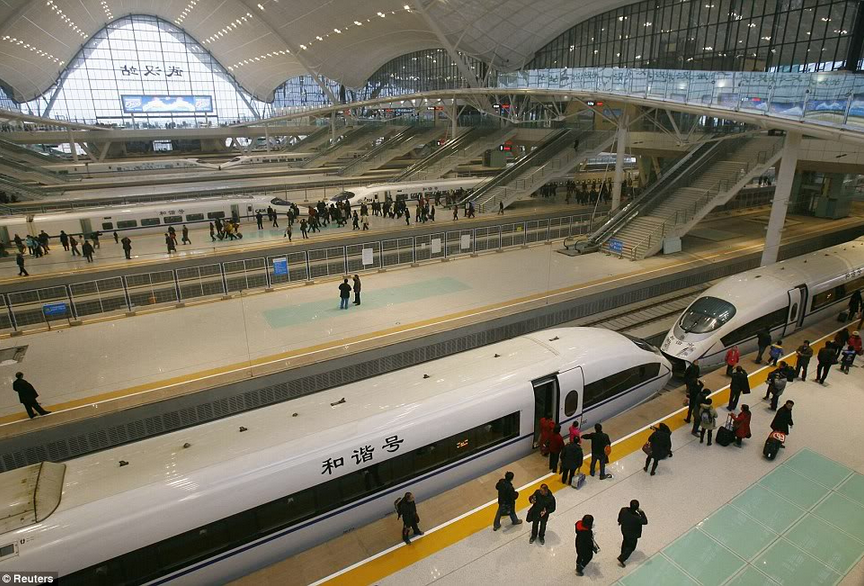The tone of western reporting about Chinese high speed rail has been fairly negative. Stories of safety concerns, lack of ridership, excessively high ticket prices that the Chinese cannot afford, inability to compete with the discount airlines, “white elephants,” etc.
The safety concerns always mention the Wenzhou accident, which means the evidence has a sample size of precisely one. And as we just saw in Spain, accidents can happen anywhere. Maybe China’s high speed rail is dangerous, but I don’t see the evidence.
When I took a high speed rail trip from Beijing to Shanghai last year, the system seemed far more crowded than during my previous HSR trip in 2009. And this Credit Suisse article suggests that some of the ridership fears may be overdone:
China is already home to the world’s longest high-speed rail line and some of its fastest bullet trains, and the government is pouring billions of yuan into building new capacity. In fact, China plans to add more than 3,100 miles of high-speed rail track by 2015, bringing the total length of the system to about 9,000 miles. Meanwhile, China’s airlines are also growing rapidly, with nearly 100 new airports planned by 2020. . . .
The major concern of the market is that the airlines will cut airfare to protect their market shares, and that load factors (a measure of how full flights are) could be substantially lower than the levels before the launch of high-speed rail,” they wrote. However, the analysts go on to say that such fears are probably unfounded. China’s fast-growing middle class is more mobile than ever, and should do enough traveling in the future to keep both sectors healthy. In addition, the competition will be most heated on short routes, a realm in which airlines have already shown a willingness to cut their losses early and avoid costly price wars. . . .
Airlines Adapting Rapidly
Chinese airlines have already showed a canny knack for maintaining profit margins by quickly responding to increased competition. Last December, when China’s newest high-speed rail line opened – a 572-mile [900 kilometer] high-speed line connecting the northeastern cities of Harbin and Dalian – most airlines simply left the market, cutting routes that overlapped with the rail corridor and shifting planes to other, less competitive routes. “We see this swift capacity adjustment, instead of cutting their airfares and profit, as a good sign that airlines can be nimble in competing [with bullet trains],” Credit Suisse analysts wrote. “While rail will remain a major competitor in the domestic market, its impact has largely been reflected in airline fleet planning strategies.” . . .
Taiwan Setting a Precedent
The caveat: Chinese consumers have shown themselves to be very price-sensitive, and a high-speed rail fare cut could pose a serious risk to airlines, Credit Suisse warned. Taiwan offers an interesting precedent. In 2007, the year high-speed rail lines opened for business in Taiwan, air carriers pared back capacity on the critical route from Taiwan city to Kaohsiung, the territory’s second-largest city, by nearly 44 percent. In an effort to undercut train prices that were 15 to 32 percent lower than airplane tickets, airlines cut fares by an average of 36 percent. Not to be outdone, high-speed train operators responded by slashing their prices an additional 20 percent. At that point, the airlines cried mercy: By the end of 2008, every airline with the exception of Mandarin Airlines had stopped flying the route. And Mandarin eventually conceded defeat in 2012.
Lowest Rates in the World
For now, a major move to cut rail ticket prices doesn’t seem likely, the analysts said. For one thing, though bullet trains are significantly more expensive than China’s highly subsidized “slow trains,” the rates are still relatively affordable – an average worker’s monthly income buys 24 tickets on a fast train in China, higher than the 23-ticket global average. In fact, Chinese high-speed rail fares are the lowest in the world, with an average price that is 36 percent lower than the cost of an airline ticket.
I’ve argued that the Chinese HSR network was built a bit too soon, especially in some of the less developed areas. Perhaps they should have focused on establishing rights of way. But I see no reason to believe that the massive infrastructure investment in Chinese HSR won’t be a major success, especially compared to Europe, which is less densely populated than eastern China. Chinese incomes are rising rapidly, they’ll grow into the system.
We used to read lots of stories about how the Chinese economic boom was only in the coastal areas, and that the interior has been left behind. That wasn’t even true in the old days, although the interior was and is still poorer. When I arrived by train at the central Chinese city of Wuhan in 1994 I felt like I was in Calcutta, swept along by a mob of people in a crowded, dirty and confusing train station. Here’s Wuhan’s HSR station today, in the “backward” part of China:
PS. Earlier I did a story that discussed Chinese subway development, an even bigger success story. One report I read suggested the crowding problem is due to a lack of cars, not a lack of line capacity. And that can be traced to protectionism. China can’t build subway cars fast enough, and domestic content rules prevent imports. It was in a comment section, so I don’t know if it’s true.
